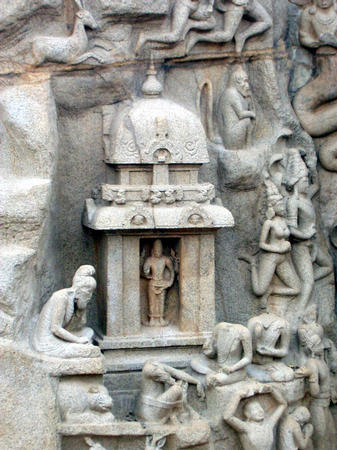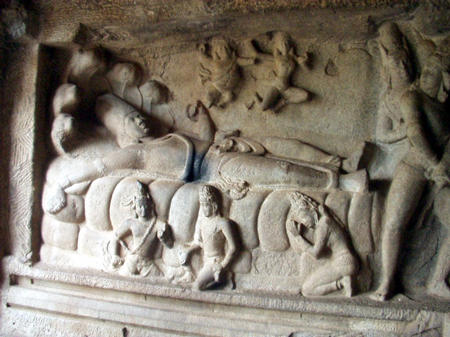Beauty of this sculptural panel is that it is the depiction of the poetry of Bharavi, a poet during the Pallava period. The beauty of this panel is that it depicts poetry through a scultors eye. He describes a dramatic scene from the Mahabharata where arjuna does severe penance to aquire various weapons for war, from the Gods. This is one such story where Shiva tests Arjuna's devotion by being a hunter opponent who kills a wild boar at the same time as arjuna strikes it as well. Here Shiva, disguised as a hunter comes to Arjuna who is going through severe penance to aquire the "pasupatastra". Interesting name that denotes the pasupata cult of shaivism.

Thats the story. Now lets look at its reference with respect to the panel, and in relation to Vishnu. Through out vishnu's vahana Garuda, has been replaced by a boar, the Varaha incarnate. Yet in this panel there seems to be no reference to a boar, that was supposed to kill arjuna and definitely was not supposed to be Varaha.
Secondly, in the profound drama taking place across this panel, which strongly represents shaivism, there seem to be hints of Vaishnavite flavour in select areas. This picture displays Vishnu in true form, in Samabhanga pose( stiff, back straight, hand resting on hip) in a strong brahmin environment where, there is depicted a sage who is shown as a scribe here, with a few other headless disciples listening to his possible discourse. The ambience of a village or a gurukul has been most beautifully brought out.
This seems to be located near a river, which is brought to life every time it rains at mahabalipuram (a rarity around Chennai these days). Next to him are a series of sages taking a bath and worshipping the sun god. It is interesting to note that in the middle of this theatrical event, Vishnu has gathered a special place as the deity in a shrine, at the bottom of this panel. This is probably the only place where he is represented in this form.


